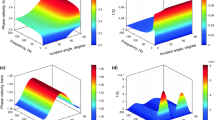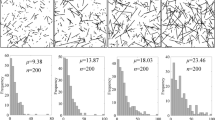Abstract
The presence of fractures in reservoir rocks causes scattering of seismic wave energy. In this paper, we utilize the finite-difference modelling technique to study these scattering effects to gain more insights into the effects and assess the validity of using anisotropic wave scattering energy as a diagnostic tool to characterize fractured hydrocarbon reservoirs. We use a simplified fractured reservoir model with four horizontal layers with a fractured-layer as the third layer. The fractures are represented by grid cells containing equivalent anisotropic medium by the use of the linear slip equivalent model. Our results show that the scattered energy, quantified through estimates of the seismic quality factor (Q) is anisotropic, exhibiting a characteristic elliptical (\(\cos 2\theta \)) variations relative to the survey azimuth angle \(\theta \). The fracture normal is inferred from the minor axis of the Q ellipse. This direction correlates with the direction of maximum wave scattering. Minimum wave scattering occurs in the fracture strike direction inferred from the major axis of the Q ellipse. These results provide more complete insights into anisotropic wave scattering characteristics in fractured media and thus, validate the practical utility of using anisotropic attenuation attribute as an additional diagnostic tool for delineation of fracture properties from seismic data.











Similar content being viewed by others
References
Bakulin A, Grechka V and Tsvankin I 2000 Estimation of fracture parameters from reflection seismic data – Part 1: HTI model due to a single fracture set; Geophysics 65(6) 1788–1801.
Bansal R and Sen M K 2008 Finite-difference modelling of S-wave splitting in anisotropic media; Geophys. Prospect. 56 293–312.
Behura J and Tsvankin I 2009 Estimation of interval anisotropic attenuation from reflection data; Geophysics 74(6) A69–A74.
Berenger J-P 1994 A perfectly matched layer for absorption of electromagnetic waves; J. Comput. Phys. 114 185–200.
Burns D R, Willis M E and Toksöz M N 2007 Fracture properties from seismic scattering; The Leading Edge 26(9) 1186–1196.
Cerjan C, Kosloff D, Kosloff R and Resef M 1985 A non-reflecting boundary condition for discrete acoustic and elastic wave equations; Geophysics 50 705–708.
Chapman M 2003 Frequency-dependent anisotropy due to meso-scale fractures in the presence of equant porosity; Geophys. Prospect. 51 369–379.
Chew W C and Liu Q H 1996 Perfectly matched layers for elastodynamics: A new absorbing boundary condition; J. Comput. Acoustics 4 341–359.
Chichinina T, Sabinin V and Ronquillo-Jarillo G 2006 QVOA analysis: P-wave attenuation anisotropy for fracture characterization; Geophysics 71(3) C37–C48.
Clark R A, Benson P M, Carter A J and Guerrero Moreno C A 2009 Anisotropic P-wave attenuation measured from a multi-azimuth surface seismic reflection survey; Geophys. Prospect. 57 835–845.
Clark R A, Carter A J, Nevill P C and Benson P M 2001 Attenuation measurement from surface seismic data – Azimuthal variation and time lapse case studies; 63rd Conference and Technical Exhibition, Expanded Abstracts, EAGE, L-28.
Clayton R and Engquist B 1977 Absorbing boundary conditions for acoustic and elastic wave equations; Bull. Seismol. Soc. Am. 67(6) 1529–1540.
Coates R T and Schoenberg M 1995 Finite-difference modelling of faults and fractures; Geophysics 60(5) 1514–1526.
Crank J and Nicolson P 1947 A practical method for numerical evaluation of solutions of partial differential equations of the heat-conduction type; Proc. Cambridge Philos. Soc. 43 50–67.
Cui X 2015 Seismic forward modeling of fractures and fractured media inversion; PhD Thesis, University of Calgary.
Dasgupta R and Clark R 1998 Estimation of \(Q\) from surface seismic reflection data; Geophysics 63(6) 2120–2128.
Ekanem A M, Wei J, Li X-Y, Chapman M and Main I G 2014 Effect of fracture aperture on P-wave attenuation: A seismic physical modelling study; ISRN Geophysics 2014 Article ID 241279.
Ekanem A M, Wei J, Li X Y, Chapman M and Main I G 2013 P-wave attenuation anisotropy in fractured media: A seismic physical modelling study. Geophys. Prospect. 61(suppl. 1) 420–433.
Fornberg B 1988 Generation of finite difference formulas on arbitrarily spaced grids; Math. Comput. 51(184) 699–706.
Festa G and Vilotte J-P 2005 The new mark scheme as a velocity-stress time staggering: An efficient PML for spectral element simulations of elastodynamics; Geophys. J. Int. 161(3) 789–812.
Gottschamer E and Olsen K B 2001 Accuracy of the explicit planar free-surface boundary condition implemented in a fourth-order staggered-grid velocity-stress finite-difference scheme; Bull. Seismol. Soc. Am. 91 617– 623.
Graves R W 1996 Simulating seismic wave propagation in 3D elastic media using staggered-grid finite difference; Bull. Seismol. Soc. Am. 86(4) 1091–1106.
Hall S A, Kendall J M, Barkved O I and Mueller M C 2000 Fracture characterization using P-wave AVOA in 3D OBS data; SEG, Expanded Abstracts, pp. 1409–1412.
Hauge P S 1981 Measurements of attenuation from vertical seismic profiles; Geophysics 46 1548–1558.
Hua L G, Fan L X and Gen Z M 2009 The application of staggered-grid Fourier pseudo-spectral differentiation operator in wavefield modelling; Chinese J. Geophys. 52(1) 214–221.
Hudson J A 1980 Overall properties of a cracked solid; Math. Proc. Cambridge Phil. Soc. 88 371–384.
Hudson J 1981 Wave speeds and attenuation of elastic waves in material containing cracks; Geophys. J. Roy. Astr. Soc. 64 133–150.
Igel H, Mora P and Riollet B 1995 Anisotropic wave propagation through finite-difference grids; Geophysics 60(4) 1203–1216.
Jeng Y, Tsai J-Y and Chen S-H 1999 An improved method of determining near-surface \(Q\); Geophysics 64(5) 1608–1617.
Johnson D H 1981 Attenuation: A state-of-the-art summary; Seismic Wave Attenuation, SEG Geophysical Reprint Series, pp. 123– 135.
Johnson D, Toksoz M and Timur A 1979 Attenuation of seismic waves in dry and saturated rocks: II. Mechanisms; Geophysics 44(4) 691– 711.
Kelly K R, Ward R W, Treitel S, Alford R M 1976 Synthetic seismograms: A finite-difference approach; Geophysics 41(1) 2–27.
Kummer B and Behle A 1982 Second-order finite-difference modelling of SH-wave propagation in laterally inhomogeneous media; Bull. Seismol. Soc. Am. 72 793–808.
Li X Y 1999 Fracture detection using azimuthal variation of P-wave move out from orthogonal seismic survey lines; Geophysics 64 1193–1201.
Liu E, Hudson J A and Pointer T 2000 Equivalent medium representation of fractured rock; J. Geophys. Res. 105 2981–3000.
Liu X, Liu Y, Ren Z-M, Cai X-H, Li Bei, Xu S-G and Zhou L- K 2017 Hybrid absorbing boundary condition for three-dimensional elastic wave modelling; Appl. Geophys. 14(2) 270–278.
Lubbe R and Worthington M H 2006 A field investigation of fracture compliance; Geophys. Prospect. 54 319–332.
Luo M, Arihara N, Wang S, Di B and Wei J 2006 Abnormal transmission attenuation and its impact on seismic-fracture prediction – A physical modelling study; Geophysics 71 D15–D22.
MacBeth C 1999 Azimuthal variation in P-wave signatures due to fluid flow; Geophysics 64(4) 1181–1192.
Madariaga R 1976 Dynamics of an expanding circular fault; Bull. Seismol. Soc. Am. 66 639– 666.
Maultzsch S, Chapman M, Liu E and Li X Y 2007 Modelling and analysis of attenuation anisotropy in multi-azimuth VSP data from Clair field; Geophys. Prospect. 55 627– 642.
Moczo P, Kristek J and Halada L 2000 3D fourth-order staggered-grid finite-difference schemes: Stability and grid dispersion; Bull. Seismol. Soc. Am. 90(3) 587–603.
Mukerji T and Mavko G 1994 Pore fluid effects on seismic velocities in anisotropic rocks; Geophysics 59 233–244.
Pujol J and Smithson S 1991 Seismic wave attenuation in volcanic rocks from VSP experiments; Geophysics 56 1441–1455.
Rathore J S, Fjaer E, Holt R M and Renlie L 1995 P- and S-wave anisotropy of a synthetic sandstone with controlled crack geometry; Geophys. Prospect. 43 711– 728.
Reine C, Clark R and van der Baan M 2012 Robust prestack \(Q\)-determination using surface seismic data: Part 1. Method and synthetic examples; Geophysics 77(1) R45– R56.
Rongrong L, Rickett J and Stefani J 2006 Angle-dependent attenuation estimates from a walk-away VSP; 76th Annual International Meeting, SEG, Expanded Abstracts, pp. 2136–2140.
Sams M and Goldberg D 1990 The validity of \(Q\) estimates from borehole data using spectral ratios; Geophysics 55 97–101.
Schoenberg M 1980 Elastic wave behaviour across linear-slip interfaces; Bull. Seismol. Soc. Am. 68 516–1521.
Schoenberg M and Douma J 1988 Elastic wave propagation in media with parallel fractures and aligned cracks; Geophys. Prospect. 36 571–590.
Shekar B and Tsvankin I 2011 Estimation of shear-wave interval attenuation from mode-converted data; Geophysics 76(6) D11–D19.
Schoenberg M and Sayers C 1995 Seismic anisotropy of fractured rock; Geophysics 60 204–211.
Schultz C A and Toksöz M N 1995 Reflections from a randomly grooved interface: Ultrasonic modelling and finite-difference calculation; Geophys. Prospect. 43 581–594.
Spencer T W, Sonnadt J R and Butlers T M 1982 Seismic \(Q\) – Stratigraphy or dissipation; Geophysics 47(1) 16–24.
Thomsen L 1995 Elastic anisotropy due to aligned cracks in porous rock; Geophys. Prospect. 43 805–829.
Tod S R 2001 The effects on seismic waves of interconnected nearly aligned cracks; Geophys. J. Int. 146 249–263.
Virieux J 1984 SH-wave propagation in heterogeneous media: Velocity-stress finite-difference method; Geophysics 49 1933–1957.
Virieux J 1986 P-SV wave propagation in heterogeneous media: Velocity-stress finite-difference method; Geophysics 51 889– 901.
Virieux J, Etienne V, Cruz-Atienza V, Brossier R and Chaljub E et al. 2012 Modelling seismic wave propagation for geophysical imaging; Seismic Waves – Research and Analysis, Masaki Kanao, Chap. 13, 253–304, 978-953-307-944-8.
Vlastos S, Liu E, Main I G and Narteau C 2003 Numerical simulation of wave propagation in 2-D fractured media: Scattering attenuation at different stages of growth of fracture population; Geophys. J. Int. 171 865–880.
Wang S, Li X Y, Qian Z, Di B and Wei J 2007 Physical modelling studies of 3-D P-wave seismic for fracture detection;Geophys. J. Int. 168 745–756.
Willis M E, Burns D R, Rao R, Minsley B, Toksöz M N and Vetri L 2006 Spatial orientation and distribution of reservoir fractures from scattered seismic energy; Geophysics 71(5) 43–51.
Winkler K W and Nur A 1982 Seismic attenuation: Effects of pore fluids and frictional sliding; Geophysics 47 1–15.
Xu Y, Chapman M, Li X Y and Main I G 2010 Fracture spacing effects on seismic anisotropy and scattering: A 3D numerical simulation study on discrete fracture models; 72nd EAGE Conference and Exhibition, Expanded Abstract.
Acknowledgements
We are thankful to Akwa Ibom State University, Nigeria for sponsoring Ekanem’s studies at the University of Edinburgh. We also appreciate the sponsors of Edinburgh Anisotropy Project for their support and permission to publish this work.
Author information
Authors and Affiliations
Corresponding author
Additional information
Corresponding editor: M Radhakrishna
Rights and permissions
About this article
Cite this article
Ekanem, A.M., Xu, Y. Finite-difference modelling of anisotropic wave scattering in discrete fracture model. J Earth Syst Sci 127, 40 (2018). https://doi.org/10.1007/s12040-018-0942-3
Received:
Revised:
Accepted:
Published:
DOI: https://doi.org/10.1007/s12040-018-0942-3




